Russians are third at MSI Master Overclocking Arena 2011 European Finals
Operation Istanbul
On April 15-16, the capital of Turkey hosted the best overclokers from Europe and the Middle East. 17 teams of two people each fought for two days for a cash prize and the right to participate in the world finals in September.
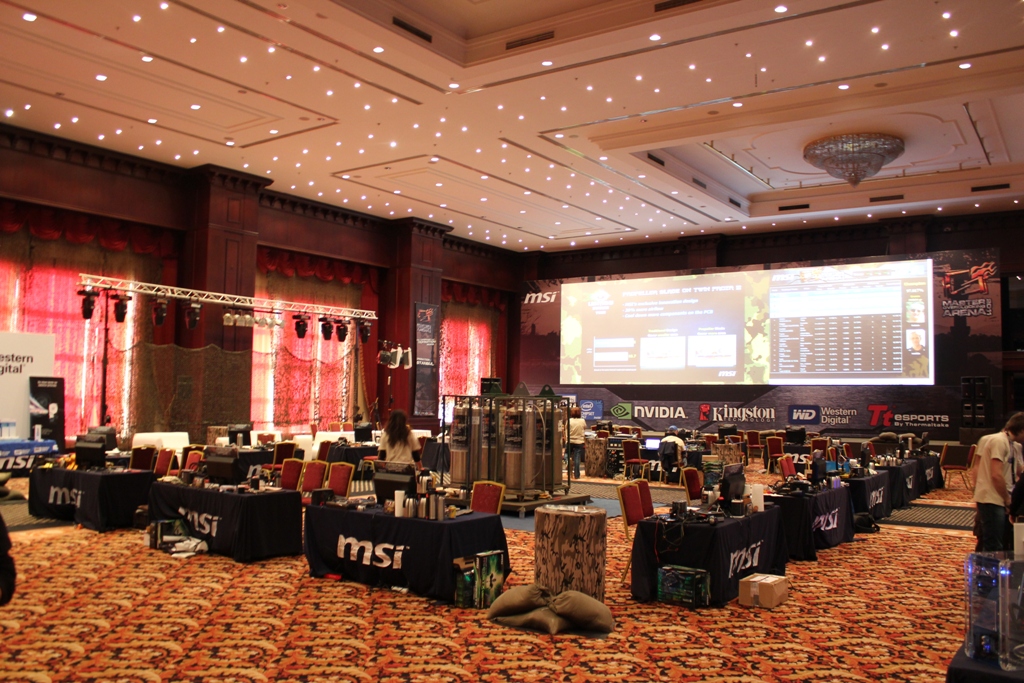
The very idea of conducting offline competitions has long been adopted by the leading manufacturers of motherboards. For the past two or three years, ASUS, Gigabyte and MSI have carried out ROG, GOOC and MOA at different intervals. But the financial crisis still affected even the major players in the market, and in 2011 only MSI was able to collect overclockers for offline competition.
')
It just so happened that the latest MSI products got a military style. Military subjects expected overklorevov and in Istanbul. To protect the honor of our country, the first two overclockers of Russia were sent according to the hwbot.org rating - Smoke (chief editor of automotive magazine “Best Motor” ) and slamms (chief editor of computer magazine “i” ).
Caution! Many images!
Rules and Regulations
MSI, unlike other organizing companies, invites two participants from each country at once. This is done because the task includes not only overclocking the processor, but also overclocking the video card. It is almost impossible to control the system with a processor and a video card cooled by liquid nitrogen, while at the same time making it work at limit frequencies alone. Even for two participants the task is very difficult.
This year, MSI took two days to the competition. On the first day, participants had to show results in SuperPi32M and 3Dmark03. And the second day was given under the new 3Dmark11.
The choice of benchmarks is very competent, because it allows you to demonstrate the maximum skills of the participants. So, SuperPi32M can be called a truly processor test, where overclockers can show their level of overclocking skill and tweaking. 3Dmark03 is an old and quite popular graphic test, the result depends both on the processor and on the video card. And a very fresh 3DMark11, where the preference is fully given to video cards, and the processor frequency has a minimal effect on the result.
MSI uses a time-tested percentage table to calculate results. Each of the tests is run with nominal settings without overclocking the components to evaluate the system. The obtained values are taken as 100 percent. As a result of overclocking, overclockers get values that exceed the nominal by a certain number of percent. The more interest in the end managed to collect, the higher the final place. Remarkable is the fact that the organizers take into account the complexity of each test. So, this time, the overall result of the tests was influenced as follows:
- 40% Super Pi32M;
- 25% 3DMark03;
- 35% 3DMark11.
Members
France - peplnerong and Boblemagnifique
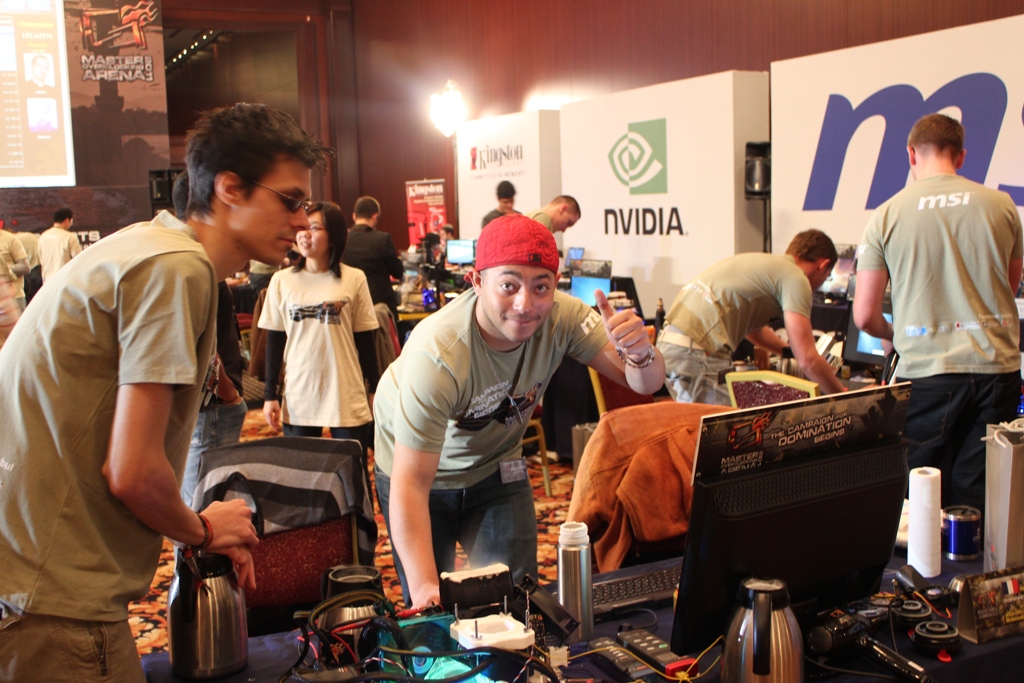
Germany - loopy83 and kabauterman
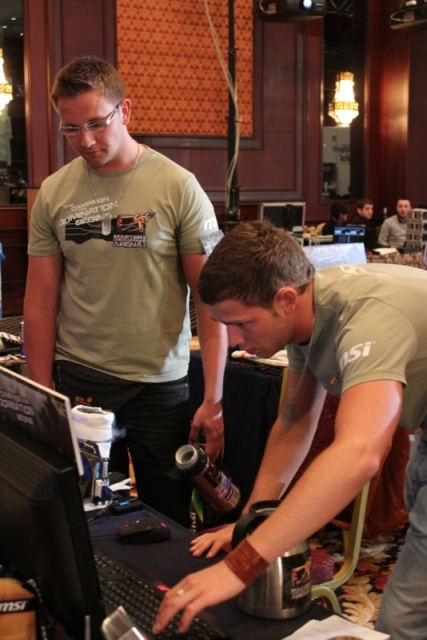
Iran - Don_Corleone and Olesius

Italy - canna1988 and KanGaXx

Poland - Kamil_Grzbecik and G.Foyle

Russia - Smoke and slamms (in the photo SteelRat (organizer from the Ukrainian office of MSI) and Smoke)
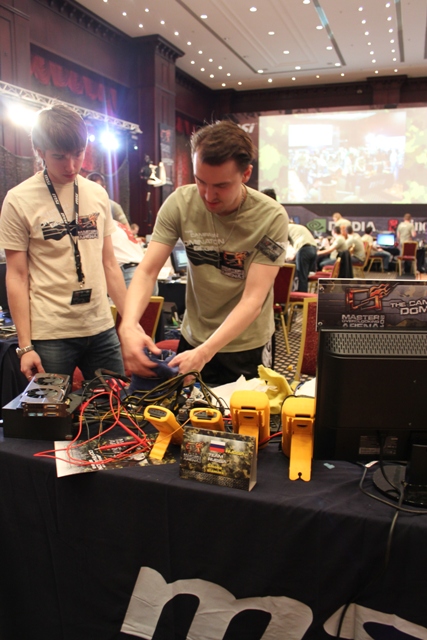
Spain - DRACO and VAK92
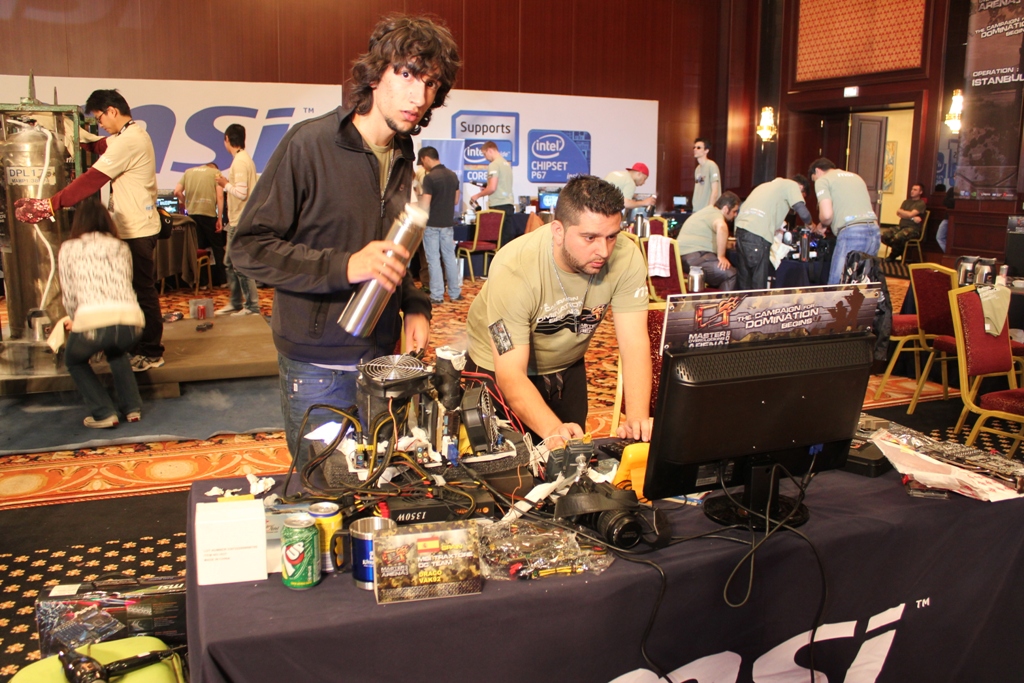
Turkey - karandiru and brandybuck
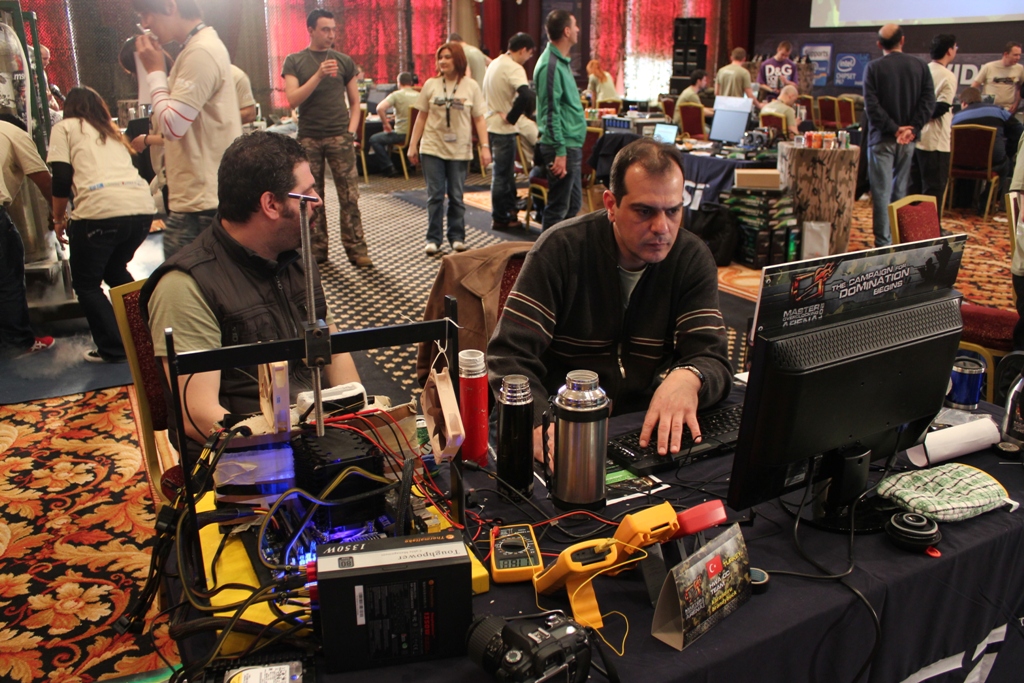
UK - RawZ and PCTwin

Ukraine - cyclone and T0lsty

Sweden (MOA 2010 winners) - elmor and ME4ME

Sweden - MeanMachine and Mink

Romania - matose and Monstru

Benelux - Massman and Pt1t
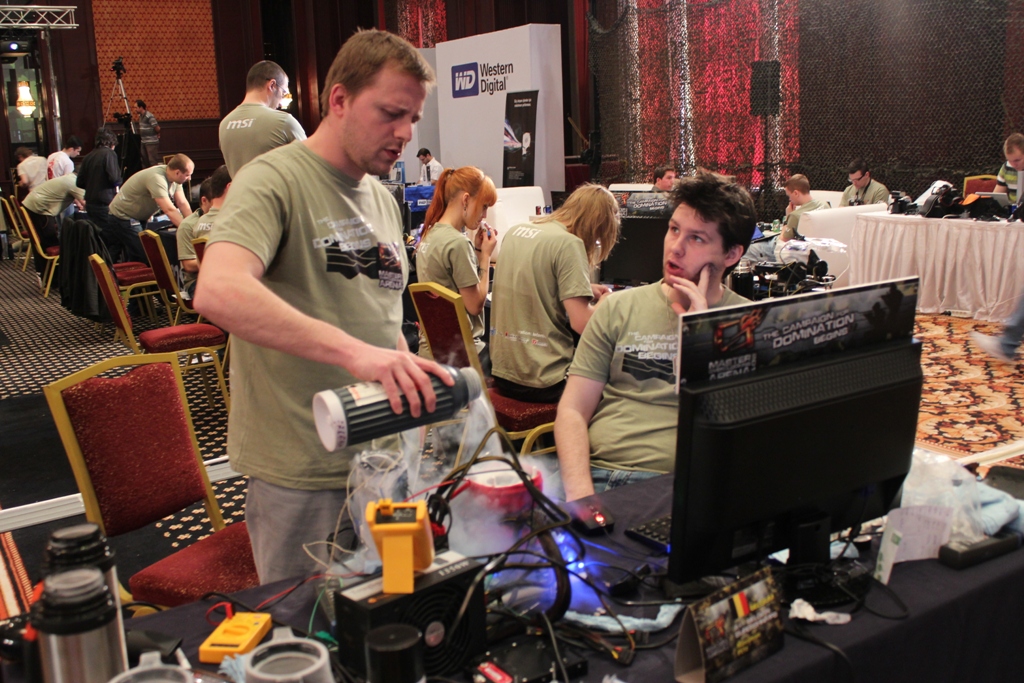
Greece - Stelaras and Aristidis
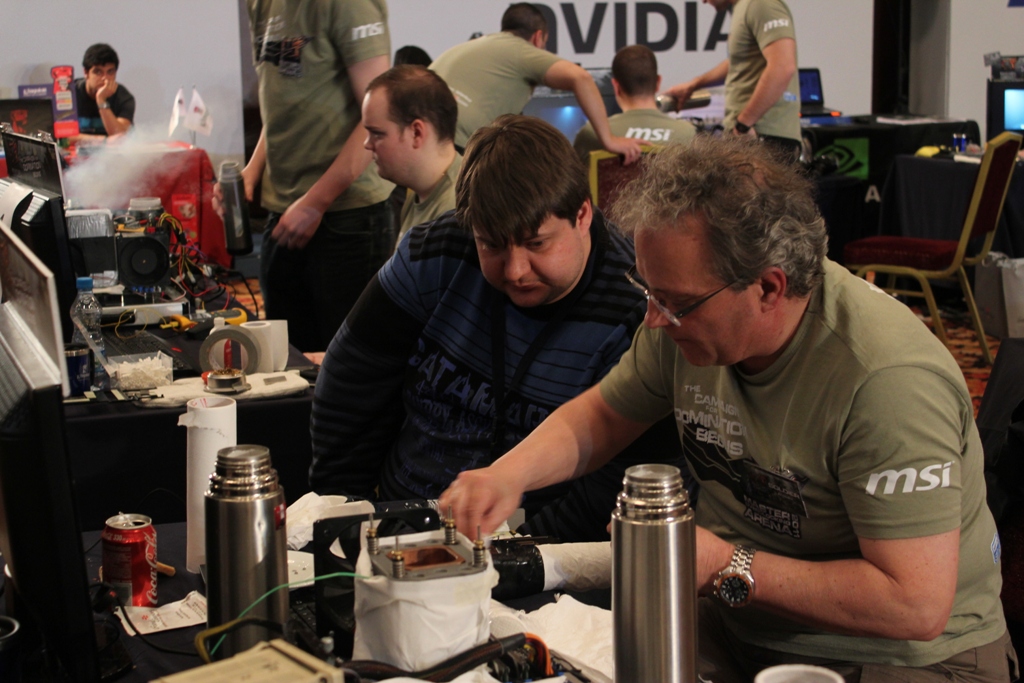
Czech Republic and Slovakia - OBR and WLK

Test bench:
motherboard MSI Big-Bang Marshal B3

MSI GTX580 Lightning video card
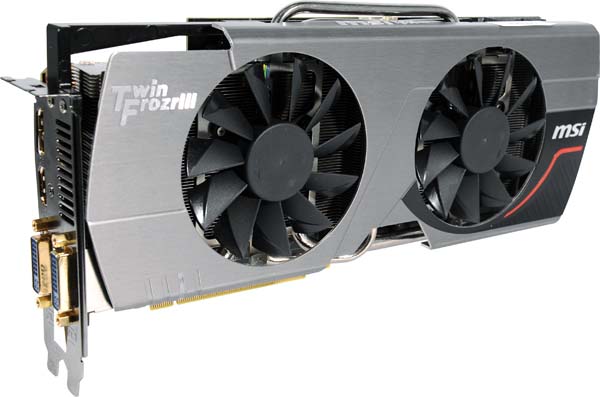
Intel Core i7 2600K processor
RAM Kingston KHX2133C9AD3X2K2 / 4GX

WD VelociRaptor WD3000HLFS hard drive
power supply Thermaltake Tougpower 1350W
keyboard Tt eSPORTS Challenger Pro
Tt eSPORTS Black Gaming Mouse
Three winners:
1st place - Romania (matose and Monstru)
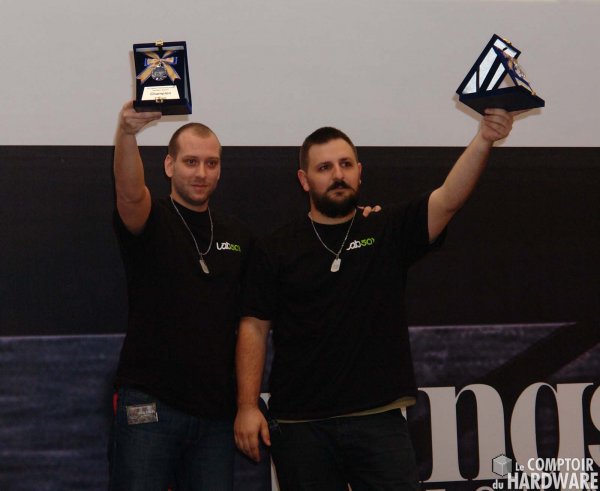
The Romanian team has a great experience of participating in competitions of this kind, so they know how important it is to shoot first. Time is one of the main trump cards of the Romanians, because the sooner you get a good result, the more you will have to improve it. Practically right after the start of the competition, the Romanian national team showed an impressive result in the Super Pi 32M - 6 minutes 25 seconds. Limiting the processor multiplier to 50 allowed us to reduce the frequency variation. The Romanian team was able to finally pass the Super Pi test at a frequency of 5355 MHz - 107.1 MHz x 50. Good knowledge in tweaking and fine tuning of the memory improved the result obtained earlier and showed a time of 6 minutes 23703 seconds. As it turned out, this result was the best among the participants.
In 3DMark03, matose and Monstru were also able to hit everyone. They were the first in the tournament who could split the figure of 150,000 marks. People who know about overclocking understand that the results are very low for such high frequencies. In fact, everything is explained by two factors - the use of the Lucid Hydra chip and the Windows 7 operating system on the motherboard. The final result is 150933 marks and second place in 3DMark03.
The next day, only 3DMark 11 remained. Romanians, as favorites of the first day, were in a somewhat relaxed state. However, this did not prevent them from showing the second result in 3DMark11 - 9656. At the same time, the frequencies of MSI GTX580 Lightning video card were raised to 1,440 MHz / 2,700 MHz for the core and memory, respectively.
152.632% overclocking was shown by the Romanian team and was ranked first on the MSI MOA 2011 EMEA finals.
2 place - Greece (Stelaras and Aristidis)

The Greek team, having learned that the European final will be held in Istanbul, was overjoyed at this fact. Still, 400 km shared by the Greek Athens and Istanbul. A few hours by car or half an hour by plane, and the Greek troops had landed for military operations.
The Greeks most of all, probably, that day smiled luck. They got a processor that was able to operate at a frequency of 5.6 GHz, and their video card ran at 1,440 MHz in the 3DMark03 core. But the correct approach to organizing the competition did not allow the Greeks, by the will of fate, to become winners. The multiplier limit has become a major problem for the Greek team. Their processor did not want to work at the base bus frequency above 106.1 MHz. However, this did not stop the Greeks from showing their best result of 6 minutes and 25.735 seconds and, after the first test, confidently took the third position.
But the graphic benchmark 3DMark03 and the result of the Greek team in it, perhaps, struck many. 154 227 marks their final result. A big lead over the competition was ensured due to the high frequency of the processor - 5670 MHz. Approximately every 100 MHz increase to the CPU can increase the result by 1000 points. Well, 1440 MHz on the MSI Lightning graphics core also played an important role in obtaining such a high result.
The second day for the Greek team, as well as for the Romanians, was relaxed and simple. Tasks to show the highest result they did not stand. The main thing was for them to carefully and step by step get enough for a pedestal result. What they actually did was, having overclocked the card to 1350 MHz by the core and received 9303 marks. As a result, deserved second place.
3rd place - Russia (Smoke and slamms)

The Russian team, like the Romanian, got into the European final without qualification. The best overclockers of Russia according to hwbot.org Smoke and slamms went to defend the honor of the Russian flag.
The first day of our guys did not work out right away. The overclocked processor Intel Core i7 2600K, rehearsed to shine at home, failed in the first minutes of the competition. The motherboard did not want to load Windows 7 above 102 MHz. About an hour of shamanism with tambourines around the motherboard did not bring success. As a result, it was decided to try the second fee issued to participants. On it it went more vigorously. 105.5 MHz for the bus and the resulting 6 minutes 30.641 seconds in the piggy bank of the Russian team.
The Russian team had very high hopes for 3DMark03, as the home map ran 3DMark03 at 1500 MHz core frequency. A couple of hours before the competition, many participants from other countries let it slip that they had removed the heat spreader cover from the GPU. Our guys hoping that this trick will help them get a little more megahertz. But after installing the glass and running 3DMark03 at 1200 MHz, artifacts began to pour around the screen. The assumptions about the lack of temperature or voltage, unfortunately, were not confirmed, so the guys could only hope for the second card. Having twisted quickly the cooling and setting the glass for liquid nitrogen, in 40 minutes the Russians were able to get 1400 MHz in the core and 146922 parrots. At the end of the first day, the Russian team was in fifth position.
On the second day, the task was quite difficult - to stay in the TOP-5. And the difficulty is that the two Swedish teams, as well as the Benelux team, had very good video cards and, therefore, could compete for positions on the podium. But the second day for slamms and Smoke turned out to be completely different. Everything worked like a clock, stable and at high frequencies. The result is the first place with a good margin in 3DMark11 with a score of 9774 marks. And as a result, the third place in the overall standings.
More details about the event, reviews of interesting pieces of iron and not only look on the pages of our magazine - i-zine.ru

On April 15-16, the capital of Turkey hosted the best overclokers from Europe and the Middle East. 17 teams of two people each fought for two days for a cash prize and the right to participate in the world finals in September.

The very idea of conducting offline competitions has long been adopted by the leading manufacturers of motherboards. For the past two or three years, ASUS, Gigabyte and MSI have carried out ROG, GOOC and MOA at different intervals. But the financial crisis still affected even the major players in the market, and in 2011 only MSI was able to collect overclockers for offline competition.
')
It just so happened that the latest MSI products got a military style. Military subjects expected overklorevov and in Istanbul. To protect the honor of our country, the first two overclockers of Russia were sent according to the hwbot.org rating - Smoke (chief editor of automotive magazine “Best Motor” ) and slamms (chief editor of computer magazine “i” ).
Caution! Many images!
Rules and Regulations
MSI, unlike other organizing companies, invites two participants from each country at once. This is done because the task includes not only overclocking the processor, but also overclocking the video card. It is almost impossible to control the system with a processor and a video card cooled by liquid nitrogen, while at the same time making it work at limit frequencies alone. Even for two participants the task is very difficult.
This year, MSI took two days to the competition. On the first day, participants had to show results in SuperPi32M and 3Dmark03. And the second day was given under the new 3Dmark11.
The choice of benchmarks is very competent, because it allows you to demonstrate the maximum skills of the participants. So, SuperPi32M can be called a truly processor test, where overclockers can show their level of overclocking skill and tweaking. 3Dmark03 is an old and quite popular graphic test, the result depends both on the processor and on the video card. And a very fresh 3DMark11, where the preference is fully given to video cards, and the processor frequency has a minimal effect on the result.
MSI uses a time-tested percentage table to calculate results. Each of the tests is run with nominal settings without overclocking the components to evaluate the system. The obtained values are taken as 100 percent. As a result of overclocking, overclockers get values that exceed the nominal by a certain number of percent. The more interest in the end managed to collect, the higher the final place. Remarkable is the fact that the organizers take into account the complexity of each test. So, this time, the overall result of the tests was influenced as follows:
- 40% Super Pi32M;
- 25% 3DMark03;
- 35% 3DMark11.
Members
France - peplnerong and Boblemagnifique

Germany - loopy83 and kabauterman

Iran - Don_Corleone and Olesius

Italy - canna1988 and KanGaXx

Poland - Kamil_Grzbecik and G.Foyle

Russia - Smoke and slamms (in the photo SteelRat (organizer from the Ukrainian office of MSI) and Smoke)

Spain - DRACO and VAK92

Turkey - karandiru and brandybuck

UK - RawZ and PCTwin

Ukraine - cyclone and T0lsty

Sweden (MOA 2010 winners) - elmor and ME4ME

Sweden - MeanMachine and Mink

Romania - matose and Monstru

Benelux - Massman and Pt1t

Greece - Stelaras and Aristidis

Czech Republic and Slovakia - OBR and WLK

Test bench:
motherboard MSI Big-Bang Marshal B3

MSI GTX580 Lightning video card

Intel Core i7 2600K processor
RAM Kingston KHX2133C9AD3X2K2 / 4GX

WD VelociRaptor WD3000HLFS hard drive
power supply Thermaltake Tougpower 1350W
keyboard Tt eSPORTS Challenger Pro
Tt eSPORTS Black Gaming Mouse
Three winners:
1st place - Romania (matose and Monstru)

The Romanian team has a great experience of participating in competitions of this kind, so they know how important it is to shoot first. Time is one of the main trump cards of the Romanians, because the sooner you get a good result, the more you will have to improve it. Practically right after the start of the competition, the Romanian national team showed an impressive result in the Super Pi 32M - 6 minutes 25 seconds. Limiting the processor multiplier to 50 allowed us to reduce the frequency variation. The Romanian team was able to finally pass the Super Pi test at a frequency of 5355 MHz - 107.1 MHz x 50. Good knowledge in tweaking and fine tuning of the memory improved the result obtained earlier and showed a time of 6 minutes 23703 seconds. As it turned out, this result was the best among the participants.
In 3DMark03, matose and Monstru were also able to hit everyone. They were the first in the tournament who could split the figure of 150,000 marks. People who know about overclocking understand that the results are very low for such high frequencies. In fact, everything is explained by two factors - the use of the Lucid Hydra chip and the Windows 7 operating system on the motherboard. The final result is 150933 marks and second place in 3DMark03.
The next day, only 3DMark 11 remained. Romanians, as favorites of the first day, were in a somewhat relaxed state. However, this did not prevent them from showing the second result in 3DMark11 - 9656. At the same time, the frequencies of MSI GTX580 Lightning video card were raised to 1,440 MHz / 2,700 MHz for the core and memory, respectively.
152.632% overclocking was shown by the Romanian team and was ranked first on the MSI MOA 2011 EMEA finals.
2 place - Greece (Stelaras and Aristidis)

The Greek team, having learned that the European final will be held in Istanbul, was overjoyed at this fact. Still, 400 km shared by the Greek Athens and Istanbul. A few hours by car or half an hour by plane, and the Greek troops had landed for military operations.
The Greeks most of all, probably, that day smiled luck. They got a processor that was able to operate at a frequency of 5.6 GHz, and their video card ran at 1,440 MHz in the 3DMark03 core. But the correct approach to organizing the competition did not allow the Greeks, by the will of fate, to become winners. The multiplier limit has become a major problem for the Greek team. Their processor did not want to work at the base bus frequency above 106.1 MHz. However, this did not stop the Greeks from showing their best result of 6 minutes and 25.735 seconds and, after the first test, confidently took the third position.
But the graphic benchmark 3DMark03 and the result of the Greek team in it, perhaps, struck many. 154 227 marks their final result. A big lead over the competition was ensured due to the high frequency of the processor - 5670 MHz. Approximately every 100 MHz increase to the CPU can increase the result by 1000 points. Well, 1440 MHz on the MSI Lightning graphics core also played an important role in obtaining such a high result.
The second day for the Greek team, as well as for the Romanians, was relaxed and simple. Tasks to show the highest result they did not stand. The main thing was for them to carefully and step by step get enough for a pedestal result. What they actually did was, having overclocked the card to 1350 MHz by the core and received 9303 marks. As a result, deserved second place.
3rd place - Russia (Smoke and slamms)

The Russian team, like the Romanian, got into the European final without qualification. The best overclockers of Russia according to hwbot.org Smoke and slamms went to defend the honor of the Russian flag.
The first day of our guys did not work out right away. The overclocked processor Intel Core i7 2600K, rehearsed to shine at home, failed in the first minutes of the competition. The motherboard did not want to load Windows 7 above 102 MHz. About an hour of shamanism with tambourines around the motherboard did not bring success. As a result, it was decided to try the second fee issued to participants. On it it went more vigorously. 105.5 MHz for the bus and the resulting 6 minutes 30.641 seconds in the piggy bank of the Russian team.
The Russian team had very high hopes for 3DMark03, as the home map ran 3DMark03 at 1500 MHz core frequency. A couple of hours before the competition, many participants from other countries let it slip that they had removed the heat spreader cover from the GPU. Our guys hoping that this trick will help them get a little more megahertz. But after installing the glass and running 3DMark03 at 1200 MHz, artifacts began to pour around the screen. The assumptions about the lack of temperature or voltage, unfortunately, were not confirmed, so the guys could only hope for the second card. Having twisted quickly the cooling and setting the glass for liquid nitrogen, in 40 minutes the Russians were able to get 1400 MHz in the core and 146922 parrots. At the end of the first day, the Russian team was in fifth position.
On the second day, the task was quite difficult - to stay in the TOP-5. And the difficulty is that the two Swedish teams, as well as the Benelux team, had very good video cards and, therefore, could compete for positions on the podium. But the second day for slamms and Smoke turned out to be completely different. Everything worked like a clock, stable and at high frequencies. The result is the first place with a good margin in 3DMark11 with a score of 9774 marks. And as a result, the third place in the overall standings.
More details about the event, reviews of interesting pieces of iron and not only look on the pages of our magazine - i-zine.ru

Source: https://habr.com/ru/post/117960/
All Articles